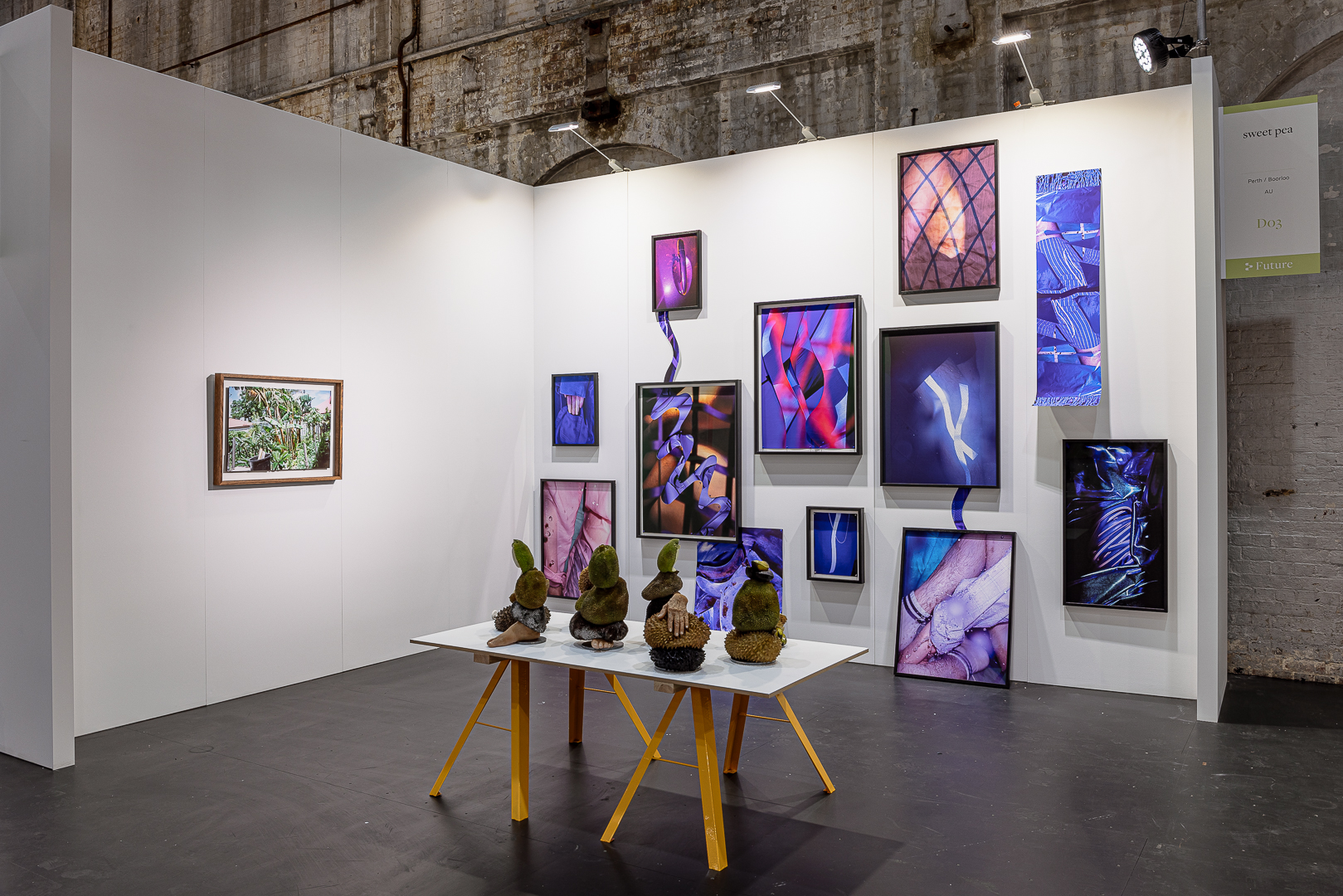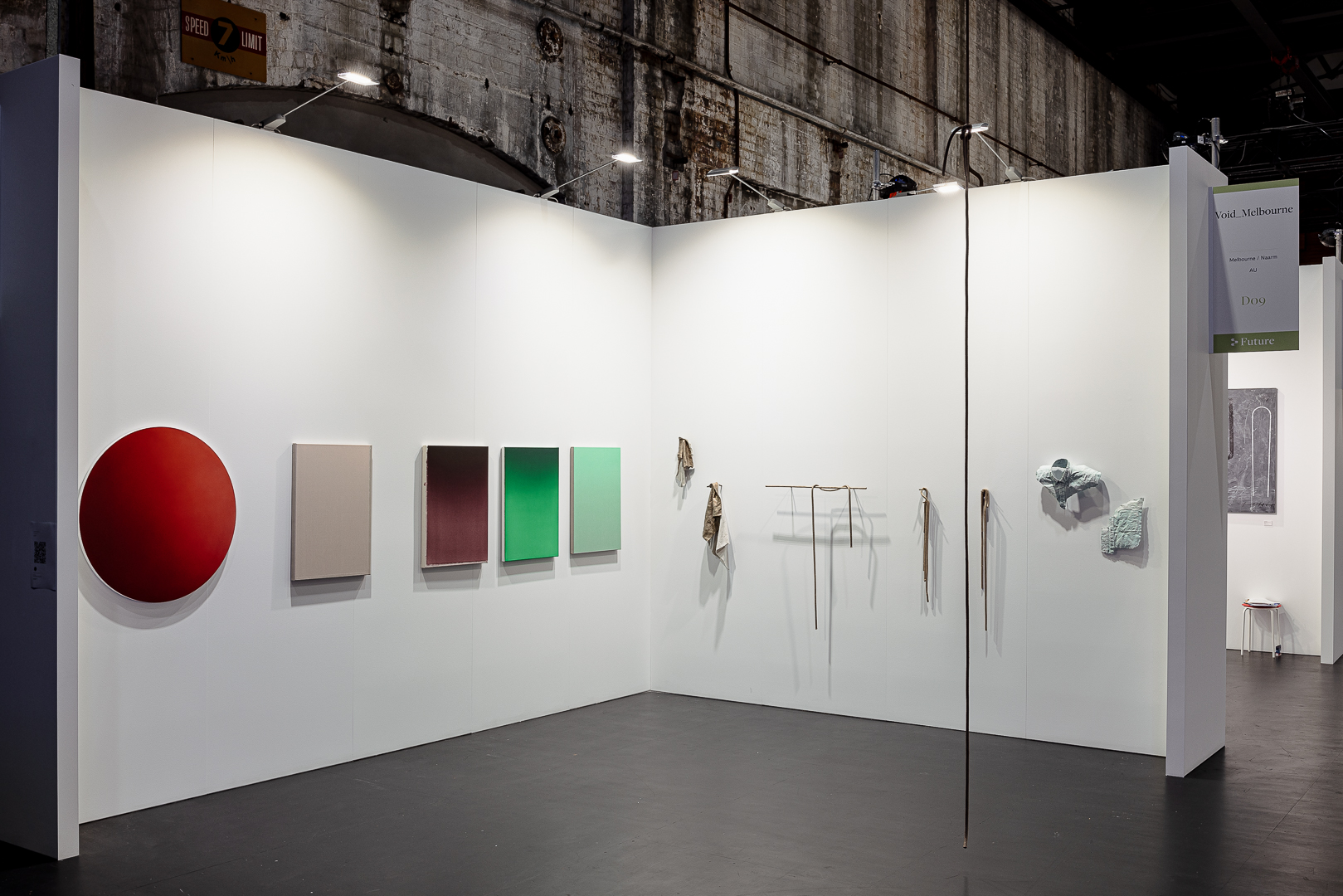Sydney Contemporary 2023, Carriageworks
07 -10 September, 2023
Buyers in Sydney only want one thing – paintings. This is about as much as I knew about the commercial art world before walking into Sydney Contemporary 2023. Admittedly, it is artist-run projects that I naturally gravitate towards. In our current wits-end moment where market deregulation and mass financialisation are pushing us to our very limits of survival under capitalism, I choose to be invested in a grassroots community of artists rather than a competitive economy of art.
Nevertheless, I was right. Buyers in Sydney only want paintings. And like… Twentieth century modernist monstrosities of paintings. Cum shots all over the canvas. Rothko-esque colour blocks. Mammoth gradients that could resurrect 2010’s Seapunk. Lines, oh my god, so many lines. Squiggly, straight, rough, every kind of line. Even I, a patron of the arts, was resorting to the tragic ancient axiom whispered in galleries around the world: ‘I could have made this.’
Ideologically unobjectionable, decorative art is what Sydney Contemporary promises. The major partner of Australasia’s leading art fair for 2023 is MA Financial Group. It is no surprise that the industrial halls of Carriageworks, its venue partner, are fitted out with paintings that would make excellent feature pieces in the aseptic offices of actuarial accountants and asset managers. It’s deeply inoffensive art.
My rapport with the ecosystem of artist-run initiatives was not in vain. In Sydney Contemporary’s Hall D the ‘Gallery Sector’ ambitiously titled ‘Future’ promised to be a ‘dynamic platform for young galleries or Artist-Run-initiatives which have been operating for five years or less.’
Already seeing more sculptures and less paintings upon an initial scan of Hall D, the edge and verve of the ‘Future’ sector’s gallery was immediately apparent. Touché, Sydney Contemporary. Walking in, Perth/Boorloo’s emerging powerhouse sweet pea gallery, established and directed by former PICA curator Andrew Varano, was front and centre with an effervescent display of two daring artists, Jack Ball and Nathan Beard. While sweet pea is not an artist-run initiative, it is certainly pumping out a suite of critical programming in service of Boorloo’s local arts community.

With a captivating display that stretched to all four edges of a wall, Jack Ball’s photographic prints captured playful ultra-violet abstractions and striking oblique close-ups of the wet gaps and corners of anonymous figures, elucidating the erotics of ambiguity. In front were Nathan Beard’s hyper-real silicone cast sculptures which stack and suspend tropical fruits with the extremities of an elderly body, containing a sentimental moment wherein we witness the wisdom in the touch of ageing familial flesh. Critical, conceptual, bold work – what I know best.
Elsewhere, crowds were instinctively whipping out their iPhone 14s and marching toward the dancing mechanical sculptures of Teppei Yamada represented by LOKO Gallery. Rainbow silk threads joyfully animated through the force of an amplifier pumping the frequency of a heartbeat which the gallery can personalise to the choice of heartbeat of the buyer. Clever. The Tokyo-based commercial gallery hosts an ambitious residency and suite of programming committed to generating critical dialogues locally and internationally.
At the end of Hall D was a titillating display from a one-and-a-half year old commercial gallery from Melbourne/Naarm, VOID_MELBOURNE. Nancy Constandelia’s hypnotic durational paintings of glowing colour worlds balance harmoniously with the minimal bronze-cast sculptures of ropes by Todd Robinson. As if epilogues to scenes of shibari, the tensions and releases in form of Robinson’s sculptures index negotiations of relationships with apt erotic titles like ‘If you like to be sucked or bitten and I like to suck and bite you, we may enjoy one another.’

While sweet pea, LOKO Gallery and VOID_MELBOURNE presented cutting-edge work at their stalls, these galleries and the rest in Hall D were commercial, so where were the artist-run initiatives? Applications to the ‘Future’ sector’s gallery were certainly opened to artist-run initiatives by Sydney Contemporary, though Hall D was deplete of them on the day. Having showed up to the art fair with the sole intention of writing about the invocation of ‘artist-run’ initiatives, I had a mini-freakout when the copy under the ‘Future’ section in the map and pamphlet had retained all the same previous wording except had erased any mention of artist-run anything as it had stated on the website.
The erasure of ‘artist-run’ initiatives from the ‘Future’ gallery is bleakly honest. With 20sqm booths in the ‘Future’ platform costing AU $10,500 + GST, it is no surprise that artist-run spaces, which work on grassroots, not-for-profit, volunteer-run operational models, are not able to participate at Sydney Contemporary.1 It is illustrative of the fundamental challenge that has faced artist-run initiatives and arguably, artists in metropolitan centres since the all consuming neoliberal reforms of the late 1980s: the ever increasing cost of space itself.
Phillippa Bateman declares the obvious yet often forgotten truth that ‘the provision of space for artists could not be more fundamental to their conditions of production… This is after all where the process of creation, in material terms, begins and ends… or continues.’2 In 1988, Bateman, facing the mass gentrification of Sydney’s inner city, called for government policy that would ease access to studio space to ensure the social and economic survival of NSW’s artists.
Twenty five years later, Bateman’s analysis is atomistic. The inability of artists to access space due to the barriers posed by ‘decades-long, economy wide decisions about financial deregulation and favourable tax conditions for capital concentration’ cannot be sustainably addressed singularly through government policy that momentarily eases access to artist studios.3 It is only through wider systemic change that comprehensively addresses insurmountable rental costs and their trickle on effects to cost of living will artist-run initiatives sustainably find space in the future.
Even Andrew Varano acknowledges that the COVID-19 induced downturn in Perth CBD’s retail property market opened an opportunity to ‘secure good lease terms in a space that was centrally located’, allowing for the establishment of sweet pea as a self-funded gallery in 2021.4 The fruits of this access to affordable space are clear in sweet pea’s stall at Sydney Contemporary.
In essence, Sydney Contemporary is a spectacular glitzy landlord who leases stalls to its commercial art gallery tenants. In light of this, the absence of not-for-profit artist-run initiatives from the ‘Future’ sector of Sydney Contemporary is illustrative of the current state of social and economic life in Australia. Thus, it is tragically befitting that outside the walls of Carriageworks, it is the art fair’s major partners and elite audience of collectors who ultimately continue to fortify and profit from this ever domineering system.
1. Sydney Contemporary, ‘Gallery Information Pack 2023’, https://sydneycontemporary.com.au/2015/wp-content/uploads/2023/05/Sydney-Contemporary-Gallery-Information-Pack-2023-002.pdf (accessed 12 September 2023)2. Philippa Bateman, ‘The Politics of Space,’ in Adrienne Doig & Tess Horwitz (ed.), Endangered Spaces: Artist Run Initiatives in NSW, Artspace, 1988, pp. 10-14.3. Scott Robinson, ‘Getting rich on their own supply: the housing crisis and capital’s supply-side solutions,’ Overland, 3 July 2023, https://overland.org.au/2023/07/getting-rich-on-their-own-supply-the-housing-crisis-and-capitals-supply-side-solutions/ (accessed 14 September 2023)4. ‘Conversation With Galleries: Andrew Varano from Sweet Pea,’ Sydney Contemporary, https://sydneycontemporary.com.au/conversation-with-gallerist-andrew-varano-from-sweet-pea/?fbclid=IwAR34nZANq0EvmS_xkLM8Cv99MCZuMLbCzWw2CXPlcyxDgMu2ZCLEjXqA0j8 (accessed 12 September 2023)
Levent Can Kaya makes media art, curates and writes from un-ceded Wallumedegal and Burramattagal Country. His practice investigates ancient, contemporary and future sites of collectivity pertaining to race, queerness and labour. Simply, he is an avid gatho goer and club critter curious about how humans have been communing, partying and pleasuring, together, across the globe, throughout history.
